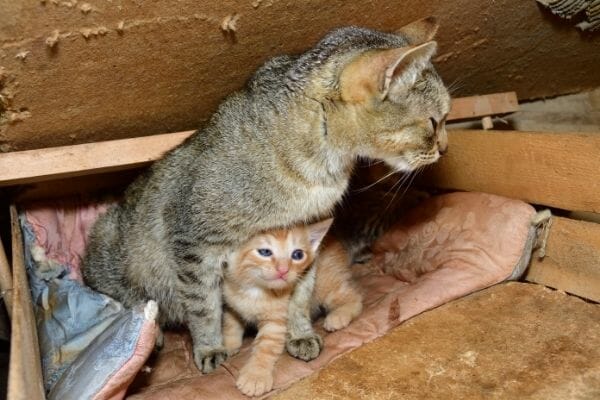Before you bring home a rescue cat, it’s a prerequisite in most countries to have the animal neutered. The procedure helps regulate cat population (especially in shelters) and reduces unwanted behaviours and cancers from developing. It is recommended for female kittens to be neutered as early as six to eight weeks of age, or at five to six months old. But what if you take in a community cat or foster a cat, and soon discover that she is pregnant? How do you deal?
When you come across a cat that’s expecting, treat her the same way you would treat a pregnant person—with lots of care! Here are 4 ways you can assist a mama cat until she’s ready to give birth:
1 Take her to the vet.
Make an appointment with the veterinarian to confirm that kittens are on the way. Ask the vet to perform an x-ray to give you a rough idea on how many kittens to expect. Since pregnant cats can also pass on some viruses to their unborn kittens, be sure her vaccination is up to date. Confirm with your vet if certain medication or treatment can be administered while she is pregnant.
When your cat shows signs of nesting (learn more about it below!), stops eating, starts vomiting, and her temperature drops below 100°F, bring her to the vet for another round of health checks. Discover how to tell if she’s actively in labour, what you should do during/after the birthing process, and when you should seek assistance from your vet.
2 Provide her with nutritious meals.
A mama cat needs to consume more calories since there are growing kittens in her belly. She is known to eat at least 50% more of her daily intake, especially when she’s about to give birth. Depending on your vet’s recommendation, give your mama cat high-quality kitten food or food specially made for pregnant cats. Make sure they are made with premium ingredients. Ease the transition by adjusting the ratio of the old and new food over the course of 7 to 10 days.
Remember that dry cat food is known to have more calories than wet cat food. If your cat prefers eating wet food, you’ll need to increase the frequency of her meals or give her larger portions to guarantee her dietary needs are met. Aside from feeding her meals packed with protein and vitamins, make sure she has access to fresh water at all times.
3 Prepare a nesting space for her.
When your cat is ready to pop, she’ll be looking for a warm and quiet area where she can give birth. This nesting instinct is accompanied by restless pacing, excessive grooming, excessive vocalisation, and a decrease in appetite. Nesting may begin as early as two days before she goes into active labour.
Provide everything she needs in this nesting space. Prepare a birthing box filled with shredded newspaper, blankets, or towels. Choose a big cardboard box with low sides that can accommodate both your cat and her litter. (A 16” x 24”-sized box would roughly fit an 8-pound cat and her kittens.) You can also place a clean towel over the box to keep out drafts. Lastly, don’t forget to place food and water bowls and a litter box nearby to encourage her to stay in her nesting area.

4 Give her what she needs.
Some cats become extra affectionate towards their owners, while others become totally antisocial or territorial. No matter which attitude she takes on, find ways to reassure her and keep an eye on her—even from a distance. Panting, uterine contractions, howling or meowing, and fluid or blood discharge are some signs that your cat has started going into active labour.
In conclusion
It takes about 12 hours for a mama cat to give birth to all her kittens. Once active labour begins, the first kitten usually arrives in an hour or so. It is normal for cats to take breaks in between birthing, cleaning and nursing their young during these times. When she is resting, offer her food such as kitten milk replacement or plain, unflavored yogurt. Prepare enough kitten formula to keep her nourished, so she can care for her kittens.
Read up on other helpful guides and interesting cat-centric stories in our blog!
Leave a comment
Your email address will not be published. All fields are required.